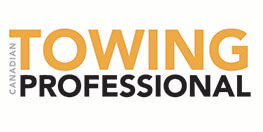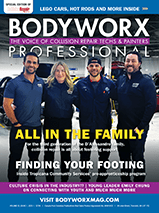A Bright future awaits those with the drive to succeed
By Darryl Simmons
AS RESULT OF THE CEASELESS TECHNOLOGICAL ADVANCEMENT OF AUTOMOBILES, A PERSONAL COMMITMENT TO SELF-IMPROVEMENT ISN’T JUST A BENEFICIAL TRAIT FOR AN AMBITIOUS COLLISION PROFESSIONAL, IT IS A VITAL ONE.
All great journeys begin with a first step, and few of life’s possible journeys are as great as a career in the exhilarating world of collision repair.
As those who make their livelihoods restoring vehicles to pre-accident condition already know well, a career in the collision sector can be immensely rewarding. It isn’t the healthy salaries offered to auto technicians that I am referring to when I talk about rewards—though the salaries are very healthy. Rather, it is the sense of purpose that so many auto repairers feel in performing their daily duties.
After all, what could be more rewarding than providing people—many of whom have recently been in serious and often traumatizing collisions—with the peace-of-mind that comes from knowing their lives may return to normal. Now it comes down to you. You hold in your hands the most comprehensive guide to training in Canada’s collision repair industry. As its publisher of Collision Repair’s 2019 Annual Training Directory, I can think of no higher honour for this issue than to serve as the first step in one of its reader’s life-changing journey into the auto repair industry.
In producing this special issue, our editorial team has done a fantastic job of contacting colleges and compiling course listings from across all provinces. From a look at the different types of training offered by Canada’s many excellent auto repair programs to the specialized training classes manufacturers offer to industry professionals, this book has it all.
From the beginning, we intended for this special issue to do more than encourage young people to consider building careers in collision repair. In fact, this issue is just as devoted to providing qualified auto technicians and painters with the information they need to hone their existing skills.
While career training in other fields might end on the date one receives one’s diploma, in the collision sector, the idea of ever being fully trained is an anathema. While this might have been the case for auto technicians until the 1980s, the arrival of anti-lock braking systems and—somewhat later—onboard vehicle computers, this era came to an end. As the technology found within vehicles changes, technicians must learn new procedures to perform ever more complex repair procedures. As a result of the ceaseless technological advancement of automobiles, a personal commitment to self-improvement isn’t just a beneficial trait for an ambitious collision professional, it is a vital one.
To celebrate this aspect of the collision community’s culture, we have included several stories about the careers of
industry professionals who exemplify this personal commitment to expanding their collision repair skill set throughout their careers. Our hope is that, by sharing these stories, we can help to enshrine the importance of the culture-of-training within Canada’s collision community.
Whether you are a high school student considering possible career paths or a hardened industry veteran with decades of experience working in bodyshops, I invite you to take a look through the courses detailed in this magazine.
I challenge you to identify the course or training program that most interests you, and to imagine the impact enrolling in it would have on your career and your life.
If you do find yourself drawn to a particular course or program, then I urge you to steel yourself and enroll. I know the risks will be outweighed by the rewards While not everyone may have the drive, determination and talent to succeed in this field, those with the courage to try are off to a great head start. TD






















